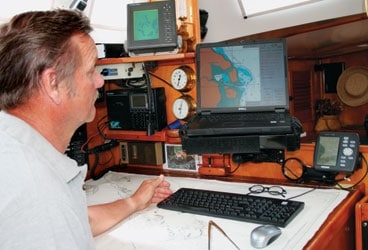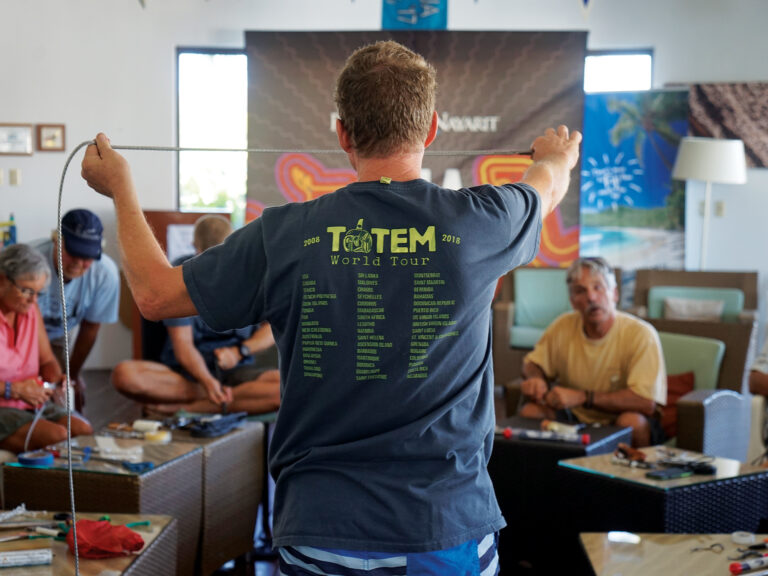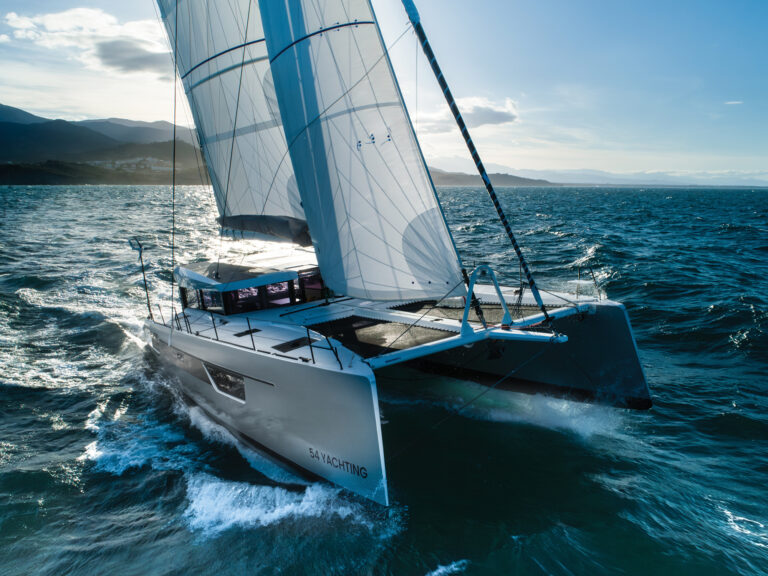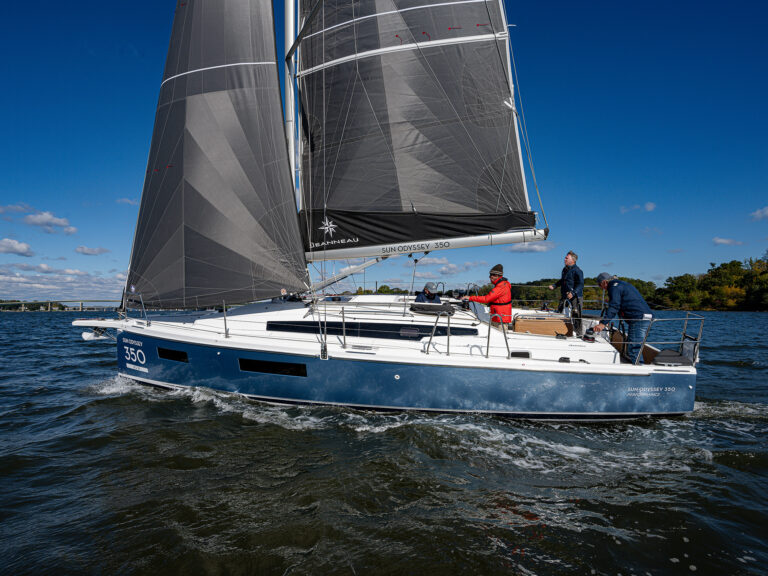
Alvahs navigation gear 368
At a recent dock party, I overheard one captain lament, “Every time I turn on the hot water, the boat turns right!” His problem seemed simple enough-an unshielded wire from the hot-water pressure pump must run too close to the autopilot fluxgate compass-but the implications were anything but. I thought, “If this happens to him every time, I can deduce that the vessel is always on autopilot, there are no manual water pumps, and no one on board suffers a cold shower. More important, the complexity of the boat systems is clearly beyond his grasp.”
When it comes to electronic equipment, my own confidence and competence are confined to the borders of the on/off switch, so as I strolled back to Roger Henry, my 36-foot steel cutter, I thought that while the nature of my boat has changed over the years, the nature of nature hasn’t. That is, in spite of the added safety and convenience that my burgeoning electronic equipment offers, I’m every bit as exposed as the first Phoenicians or Polynesians to the vagaries of the sea: lightning strikes, flooding, the corrosive effects of salt air. In spite of my pride in having finally plugged into the 21st century, I reluctantly forced myself to repeat it out loud like a litany: “It will break down. It will break down.”
That said, I wasn’t contemplating some kind of idealistic return to the “good old days.” I always look carefully at those little drawings of half-sunken ships on my chart. The beams and bones of failure, they’re scenes of abject fear and tragic loss of life. Had any one of those captains been offered a technology that would’ve pierced the cloak of darkness, predicted the weather, immediately fixed his or her position, or propelled the boat out of harm’s way, not a one would have lingered in nostalgia.
Nevertheless, I had to ask myself if the depth of my skills and the redundancy of my equipment mitigated my growing dependency on vulnerable electronics. I decided to take stock: I’d follow every tendril of copper wiring to assess the extent of my electrification project, determine how I’d cope with an electronic failure by either utilizing duplicate or parallel equipment or compensating for the loss in some other way, then decide if I needed to do anything different.
[pagebreal]
What I Learned First
I was shocked to find myself crawling from stem to stern, from masthead to deep in the bilge. One wire even led to my galley! That solenoid between the LPG tanks and the stove meant that I now depended on 12 volts of uninterrupted direct current to get a cup of piping hot coffee!
Sure I had backups; what sailor doesn’t? But did they share any common links? Having a spare alternator and two spare regulators does little good if the problem is the starting motor. Redundancy, then, might be best described as the duplication and separation of functions.
As an example: A sailor’s exhaustion at sea inevitably leads to poor judgment, the loss of coordination, and lethargy in the face of essential energetic action. Thus, I believe self-steering equipment to be among the most important on board. With that in mind, I have an Autohelm 4000 ST Tiller Pilot backed up by two spare tiller-drive arms. Recently, this Autohelm developed a deeply disturbed mind of its own and began to steer erratically. Never mind; it can be fixed. Somewhere in the bilge is stored an extra fluxgate compass and a complete control unit. All of which are worthless, however, if the batteries fail. My ungainly old Aries windvane retains its station on the transom, where it does yeoman’s work without electricity or complaint. In the unlikely event it should fail, I’ve worked out a viable sheet-to-tiller arrangement that, if the boat is balanced, can steer a course long enough to free me to tend to other essential chores. As a final fallback plan, I have my Kiwimatic Steering System, otherwise affectionately known as Diana.
Get the Lead Out?
Let’s continue on my tour of Roger Henry’s electronics.
I have a motor, and I use it too often. But an engine is a chain of a thousand parts, many electronic and sensitive, and the failure of any one can render the whole thing useless. Complete tools and spare parts aside, the best backup is, in a sense, no engine at all-that is, I try to ensure that the boat’s design and equipment are such that it can sail itself to safety. This is dependent on a coalition of factors: keeping the boat light, in trim, with low windage, efficient sheeting angles, and crisp sails. It also requires that I keep current my skills for managing the vessel under sail in open and tight quarters.
Once started, a diesel engine will still run even if the charging system fails. That’s if the lift pump doesn’t require 12 volts. I checked Roger Henry’s robust hand pump that lifts fuel from the keel tank to a header tank, which then relies on gravity to feed the engine. My old Golden Hind had a hand-cranked 16-horsepower Volvo that made it completely independent of battery power. I’m still theorizing-perhaps it’s fantasizing-on methods to start Roger Henry’s larger Perkins 30 without batteries.
On most small vessels, the main engine provides propulsion and generation. Without an outside source of electrical generation, a closed loop results: one that needs the engine to charge the batteries and the batteries to start the engine. Problems can lie within a chain of parts or a chain of events, such as leaving the battery selector switch on “both” while coincidentally leaving a silent but high-amperage implement on.
The “both” position of my selector switch is strictly verboten, and the main breaker is turned off whenever we leave the vessel. (Only the electric bilge pump is wired independently of this switch.) But in the event of a total drain, I have an Air Marine wind generator and a 48-watt solar panel as renewable sources of energy.
Should downflooding wipe that loop out entirely, I carry waterproof 12-volt lithium expedition batteries with an amp capacity sufficient to drive the GPS, VHF, depth sounder, and compass light. Nevertheless, I have manual backups for even those functions. For example, when we were en route to Cape Horn, Roger Henry’s depth sounder failed. I wasn’t about to let a 20-cent transistor thwart my lifelong sailing dream. For the next six months, Diana and I explored the tortured terrain of the uttermost south with me at the bow swinging my trusty lead line, properly shaped, marked, and armed with tallow, and calling out the readings just like the mariners of old.
Still Seeing Stars
After years of tracking celestial bodies as they slid between the clouds like ducks in a shooting gallery, I finally and reluctantly laid down my trusted sextant and installed a Garmin 75 GPS. If anything, it proved too reliable, as it didn’t miss a beat for a decade. In fact, in the high Arctic, the extreme dip made the compass card unreadable, the magnetic north pole was actually south of us, and in any event, the magnetic field was too weak to turn the compass. With the slightest forward speed, the GPS gave us a course, our only directional point of reference, for with the sun circling the horizon, there was no easily discerned east or west.
But when the screen came up blank one day, I felt a form of vertigo, as if I were falling off the edge of the world. Thankfully, we’d continued to plot our positions regularly, so at least we had a recent fix from which to initiate a dead reckoning course and proceed.
Upon landfall in the civilized world, I replaced the GPS-75 with Garmin’s workhorse model GPS-128. Albeit slowly, I eventually learn my lessons, and I now back that up with a portable Garmin 76 that’s wrapped in a foil Faraday cage to protect it from lightning and stowed in the waterproof overboard barrel. Antiquated as it sounds, I also keep my trusty sextant, a current almanac, and sight reduction tables on board.
Good sense aside, a VHF radio is now a legal requirement in many countries. I keep one charged handheld VHF in the cockpit to back up the 25-watt main VHF, and I keep a third in the ditch kit to back up the second. Coupled with the handheld GPS, these devices become an emergency system that in turn provides redundancy for our EPIRB, in that one can determine and broadcast their exact position hourly from a life raft.
Then There’s a Bucket
There’s nothing more basic to a boat’s safety than the bilge pump. I’m an advocate of electric pumps, as big and as many as possible. I have a Rule 3700 GPH wired directly to the battery with a float switch; in an emergency, it will act like an extra crewmember. But it’s useful only until the water reaches the level of the lowest electric terminal. Beneath the companionway on Roger Henry is a double-action Plastimo manual pump, and in the spares locker there’s a complete rebuild kit. Two hand pumps lie in the bow, and we keep three stout buckets in the cockpit, just in case all else fails. Still, I have plans to add a Y-valve to my Lavac head pump, converting it into yet another manual bilge pump.
By their very number, cabin lights generally back themselves up-until their shared power source fails. We keep a brass kerosene hurricane lamp hanging in the central cabin as a long-term backup.
Still, when an unforgiving wave smashes its way below, all hell and everything else breaks loose. In that terrifying, topsy-turvy darkness, you need a light to find a light, and it’s no time to be fumbling through drawers in search of one. We keep several waterproof flashlights on board, and I checked that they were secured in their accessible and designated brackets spaced around the boat. Even these flashlights don’t share the same power source. I laid out the battery-powered flashlights, a solar-powered light, and even a magnet-and-coil shake light.
When the barometer drops precipitously, I’ll tape a chemical lightstick to the center post of the cabin. No matter the chaos below, this can be easily found, then activated by simply hitting it hard. With no connections, no filaments, and no switches, it won’t fail. It provides eight hours of sufficient light to begin the work of medical attention, pumping, and damage assessment.
I have radar because while in the dark or fog, GPS and C-Map may tell you exactly where you are, but they fail to mention that billion-ton iceberg grinding down on you. Sharp ears, exposed skin sensitive to wind and temperature changes, a good lookout, and a high-candlepower spotlight become good backups for when the magnetron inevitably conks out.
I have a bad back and a good wife. Both flare up occasionally. ” I will not go sailing with you again until you install an electric windlass,” Diana insisted. You have to know when you’re beat. A Maxwell 1200-watt vertical windlass now glistens on our foredeck. Retrieving the heavy anchor is as simple as stepping on the deck switch. But I still view the thing with a deep mistrust, and I’ve already worked out the fairleads and the systems of purchase for when it inevitably betrays me.
We don’t own a watermaker. Diana would finish that sentence with the word “yet,” as she loves fresh water. Should we buy one, I’d still keep the tanks full. And I’d keep our jerricans, collection tarps, and funnels, for they’re basic and reliable lifesaving equipment. And no matter how intrusive, those manual water pumps stay right were they are.
I’m vaguely embarrassed to admit that there’s a brand-new wire running from my electrical panel to an insulated box in the bow. At the end of that wire, little electrons pleasantly agitate a small compressor, which chills cans of beverages that, in turn, pleasantly agitate me. In the spirit of deep redundancy, should one of those cans be inadvertently drained, I have a backup, and of course backups for my backups. The serious point is that while we might enjoy this chilly convenience, we don’t rely upon it. For offshore cruising, our main food supplies are canned or dehydrated, or they’re long lasting in their natural state, such as cabbages, eggs, jerky, beans, and rice. And I made provisions to bypass the solenoid so we can cook without electrical power.
The correct time is critical to precise navigation. If I have electricity, I can get it accurately from numerous sources: by radio on WWV, via my GPS, or from my battery-powered ship’s clock. After a flooding, however, I’d be scrambling for a time fix if it were not for the continuously updated waterproof dive watches we carry.
For gathering weather information via voice or weatherfaxes via the laptop, a high-quality shortwave receiver with a beat frequency oscillator acts as a backup for the SSB. Our laptop itself is duplicated by its antiquated but still-running predecessor, and it’s powered by a 110-volt inverter, a backup 220-volt inverter, or the separate 12- to 19-volt step-up converter I added.
Rules by Which to Sail
I wish it went without saying, but for all the marvels of C-Map, we stock a complete list of traditional paper charts for our intended destinations, and we fix our position on them regularly.
A chart plotter can be an amazingly accurate way to retrace one’s steps in the event of a crew-overboard situation. Nevertheless, below is the last place I want to be if someone’s in the water. In my calmest state, I’m just competent at entering new waypoints and routing instructions. How would I fare when absolutely frantic and in need of the COB function? We’ll use these new tools, but we’ll never rely upon them solely.
Instead, first and foremost, we always wear our harnesses with a strobe light attached. Next, we continue to enter our position, course, and speed hourly in our logbook. Should one of us wake up to an empty cockpit, that last entry in the book becomes vital information that the electronic system doesn’t provide. Our plan is to shout out loud our course, then its reciprocal-and we practice this-because this etches it accurately in our overly anxious minds. Next, we plan to throw overboard such floating visual aids as cushions, the flagpole, and a light to help us jibe or tack accurately onto that reciprocal.
The theory of redundancy runs from such critical actions down to the most mundane of details, such as ventilation. Electric fans are a real comfort in the doldrums, but don’t replace dorades or opening hatch covers. We still carry hand fans and mist bottles on board.
To add to the lengthening list of backups, I added a set of battery-operated navigation lights should the masthead tricolor fail or in the event of cataclysmic dismasting.
I could go on. The point of this exercise was to identify every single electrical function on board, assess how I’d end-run a failure with duplicating or parallel equipment, or compensate for the loss of that function in an entirely different way. I decided it was better to play the game of “What If?” beforehand than “I Wish I Had” after the fact.
At the end of my exercise, I concluded that I needn’t have worried. I began my sailing career in a 26-foot Belizean sloop made with hand-hewn mahogany planks and sporting a mangrove mast, a bamboo boom, and cotton sails. I can remember when my brother and I decided to upgrade from candles to kerosene lamps. It was a big day.
Since then, I’ve owned and circumnavigated in a simple yet rugged plywood sloop, and I’ve sailed our far more modern French steel cutter all over the world. Because of a paltry budget, at every level I’ve been forced to learn how to get by without the latest and greatest technology before somehow finding a way eventually to acquire it.
Whatever I thought of my condition at the time, I can see now that this process forced me to learn the basics of sound seamanship, added levels of competency, and fostered contingent thinking. More important, I learned that with those skills and the right attitude, I can be healthy and happy wandering our world’s oceans with or without the modern marvels, and perhaps that’s the most important backup plan of all.
Alvah and Diana Simon, sailing on board Roger Henry, are crossing the Pacific, headed for an eventual visit to the wilds of Siberia. Read Alvah’s weekly blog at the Cruising World website (www.cruisingworld.com).







